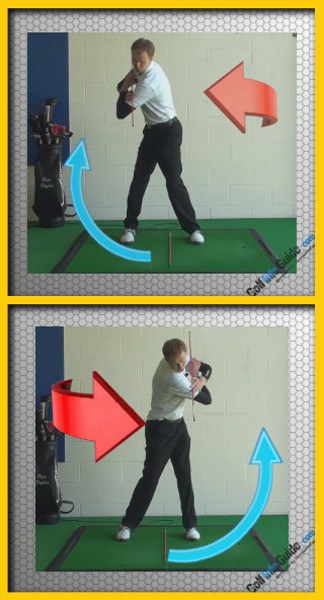- Shoulders. Obviously, it will be helpful if your shoulders themselves are flexible enough to swing your arms up into position. However, since most of the golf swing is driven by the core of your body as opposed to your arms, this is actually one of the less-important pieces of the puzzle.
- Lower back. This is where most of the twisting comes from, and the reason that many golfers have back trouble at some point along the way. Adding flexibility in this area will have a huge impact on your shoulder turn as a whole – more so than any other fitness improvement you can make. Of course, if you happen to carry a few extra pounds around the middle, losing those will usually enable your lower back to carry you farther into the backswing.
- Quads and Hamstrings. Your upper legs play a major role in the golf swing – more than most people realize. The important thing is that your legs are flexible enough so that they don’t have to give up their position in the stance while you are making the shoulder turn. Tightness in the hamstring can cause you to have to ‘stand up’ out of your stance as you reach the top of the swing. This will not only cut your shoulder turn short, but it will also get the club out of position and cause a bunch of other problems. You might not think about your legs much when you consider getting fit for the purposes of golf, but they can go a long way toward improving your game.
- One other note to keep in mind when you are planning to build an exercise routine around getting in shape for golf. Large, bulky muscles tend to do more harm than good in the golf swing, so you don’t need to worry about lifting particularly heavy weights to bulk up. Again, going back to the point about looking to professional golfers for direction, most of them are slender and fit, rather than being built like football players. Being strong helps, but flexibility is even more important in terms of building a swing that will last.

Before we get too far into the technical aspect of how you can work on your shoulder turn, it is important to talk about the role that flexibility plays in your shoulder turn. While the golf swing might not require the same level of fitness as, say, running a marathon or playing basketball, it is still an athletic motion that can benefit greatly from strong and flexible muscles. All you need to do is look around at the guys who play on the PGA Tour these days to see how seriously they take their conditioning, and the use of golf stretches for shoulder turn. Making a powerful golf swing is much easier when your body is prepared for the task.
You can go about improving your fitness any number of ways, from working with a personal trainer to exercising on your own (always check with a doctor, of course), and with the use of golf stretches for shoulder turn improvement. However, before you embark on improving your fitness with the idea of adding to your golf shoulder turn, you should know what muscles are important for the job. To complete the proper shoulder turn in golf swing, there are a variety of areas on your body that need to be flexible and ready to work. Consider the following list –
Try not to be intimidated by the thought of improving your golf fitness – you don’t need to be built like an Olympian to play good golf. Even marginal improvements in your fitness can pay off quickly on the golf course. Beyond being able to make a better shoulder turn, you also should find that you are less fatigued at the end of the round and better prepared to finish off the last few holes successfully.





